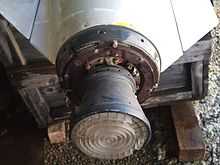R.511
| R.511 | |
|---|---|
 | |
| Type | Air-to-air missile |
| Place of origin |
|
| Service history | |
| In service | 1952–1976 |
| Used by |
Armee de l'Air Aeronavale |
| Production history | |
| Manufacturer | Matra |
| Number built | 1,500 |
| Specifications | |
| Weight | 184 kilograms (406 lb) |
| Length | 3.09 metres (10.1 ft) |
| Diameter | 0.26 metres (10 in) |
| Warhead | Blast-frag high explosive |
| Warhead weight | 30 kilograms (66 lb) |
|
| |
| Engine |
Hotchkiss-Brandt solid cast two stage motor 1,600 kg / 200 kg |
| Wingspan | 1 metre (3 ft 3 in) |
Operational range | 7 kilometres (4.3 mi) |
| Flight ceiling | 18,000 metres (59,000 ft) |
| Flight altitude | 3,000 metres (9,800 ft) to 18,000 metres (59,000 ft) |
Guidance system | Semi-active Radar Homing (R.511) |
Steering system | Twist and steer |
Launch platform |
Vautour IIN Mirage IIIC |
The R.511 was a French air-to-air missile, developed by Matra, based on their work with the Matra M.04 (R.042) and R.05. The first version of the missile, the R.510, was infra-red guided, and while accurate had very limited operating parameters.[1] The missile was superseded by the far more capable R.530 in French service, although continued to be used in training units until 1976.
Description

The R.510 was optically guided by a PbS infra-red photocell with a 20 degree field of view. Testing of the R.510 began at Hammaguir in October 1952, and a limited production run of 100 missiles were ordered. However the PbS seeker was insensitive and could only effectively track targets at night. However The R.511 entered service in 1957, replacing the R.510. The R.511 used a Thompson-CSF radar homing head which was tuned to home on reflections of the launch aircraft's radar, its antenna scanned conically 8 degrees off the boresight of the missile at a rate of 225 revolutions per second.[1] For longer range firing guidance commands were transmitted directly to the missile via an antenna on the trailing edge of the missiles wing. Limitations of the launch aircraft's radar restricted operation to above 3,000 meters.
The missile could pull 12g's while travelling at Mach 1 at 33,000 feet (10,000 m) [1]
References
- Bibliography
- Gunston, Bill (1979). The Illustrated Encyclopedia of the World's Rockets & Missiles. London: Salamander Books. ISBN 0-5172-6870-1.
- Taylor, Michael; Taylor, John. Missiles of the World. ISBN 0-7110-0712-8.